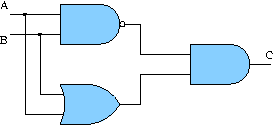Physics 8: Homework 5 Additional Questions
In addition to the problems from the book (12.E.24, 13.E.13,
13.E.15, 13.E.16, 13.P.7, 13.P.9, 13.P.11), here are
more problems that are a required part of the assignment:
- Translate the two numbers: 92 and 78 into binary form, and add them using
rules of binary arithmetic. It is critical that you show the carry
operations in your answer. Of course the answer should be the same in
decimal or binary—a fact you can use to verify your answer.
- Write the number 19 in binary. Then write down 4×19 = 76 in
binary. How are these binary representations similar and how do they
differ? How is multiplying by 4 in binary very similar to multiplying
by 100 in decimal representation?
- Produce the logic table that accompanies the following figure of a
logic arrangement involving an AND gate and an XOR gate. You may want to
refer to the gate diagram to get the logic
straight.

- Which logic function does the following arrangement of NAND, OR, and
AND gates accomplish. You may want to refer to the gate diagram to get the logic straight. Crossing
lines are not connected unless a dot appears at the intersection.

- Infrared remote controls use infrared light to command their associated
devices. Light from the sun and from incandescent light bulbs contain
plenty of power at infrared wavelengths. Why then do electronic devices
only respond to the remote control, and never to these other sources?
- How does your DVD player know not to respond to your TV's remote
control?
- Binary digital communication means 1's and 0's only: on or
off—yes or no. Why does this translate to not mattering how far you
stand from your TV when using the remote (provided you are close enough for
the TV to be able to sense the pulses of light)? Contrast this to an analog
arrangement, wherein the information would be carried via the
brightness of the transmitted light.
- When you press a button on a TV remote control, it repeatedly sends
packets of information for as long as the button is held down. But the
in-class transmitters are not this way, emitting a single packet-pair per
button press. Why do they behave differently? What could happen
if the H-ITT remotes continued to send out IR pulses as long as the button
was depressed?



